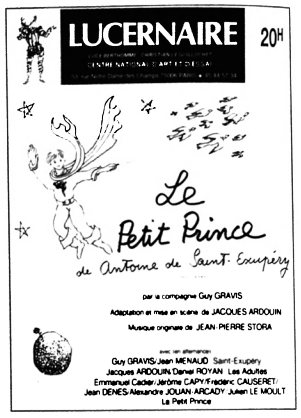6.4: Lecture
- Page ID
- 142310
Lecture
The following passage is one of the shorter episodes in Le Petit Prince, by Antoine de St.-Exupéry. Remember, as always, to read the passage first rapidly, then somewhat more slowly, trying to guess words you don't know. Don't look up any words until you've tried to understand the passage without using the dictionary, and please don't write in translations. Start reading well ahead of the day for which the reading is assigned, and read it at least four times.
By the way, whether or not you have already read this excellent story in translation, you ought to find an evening to read it in French. As you'll see from this excerpt, it is not difficult—and it is certainly worth the time you will devote to it.
Situation. Having decided, for personal reasons, to leave his own small planet, the Little Prince visits a number of planets before reaching Earth. At each one he meets an interesting character...
| La planète suivante était habitée par un buveur. Cette visite fut02 - très courte mais elle plongea0 le petit prince dans une grande mélancolie: | 0 was 0 plunged |
| —Que fais-tu là? dit0-il au buveur, qu'il trouva0 installé en silence devant une collection de bouteilles vicies et une collection de bouteilles pleines. | 0 said/found |
| —Je bos, répondit0 le buveur, d'un air lugubre. | 0 replied |
| —Pourquoi bois-tu? lui demanda0 le petit prince. | 0 asked |
| —Pour oublier, répondit le buveur. | |
| —Pour oublier quoi? s'enquit0 le petit prince qui déjà le plaignait. | 0 inquired |
| —Pour oublier que j'ai honte, avoua0 le buveur en baissant la tête. | 0 confessed |
| —Honte de quoi? s'informa0 le petit prince qui désirait le secourir. | 0 asked |
| —Honte de boire! acheva0 le buveur qui s'enferma0 définitivement dans le silence. | 0 concluded/shut himself |
| Et le petit prince s'en fut0, perplexe. | 0 went away |
| Les grandes personnes sont décidément très très bizarres, se disait-il en luimême durant le voyage. |
2 You need not worry about this past tense form (fut) as far as producing it is concerned, but we'll give you many opportunities to recognize it. It is the so-called "book tense" equivalent of the passé composé. and you'll find it in most reading passages. (Reference Grammar, 6.2.3. Remember, you have only to learn to recognize it.) All occurrences of the passé simple are glossed in the margin.

Common and Uncommon Knowledge
Last reminder: you should be able to find the answers to these questions in easily available reference works, but we urge you to use the Petit Larousse most of the time.
- Was Paris the first city to have an underground local transportation system? In Paris, they call it the métro, in New York City, they call it the subway.
- Why is the area on the left bank of the Seine, around the Sorbonne, called "le quartier latiri''?
- Name four railroad stations and two airports that serve Paris. Airport names appear in the newspapers and magazines fairly frequently. The names of the gares are all on maps of Paris, including métro maps.


